French actress Ginette Leclerc (1912-1992) starred in many films in the 1930s and 1940s. With her smouldering eyes, her carnal smile and her vulgar voice, she represented the vamp from the gutter.

French postcard in the Raimu series by MPC (Marcel Pagnol Com), no. 12. Photo: Roger Corbeau. Raimu and Ginette Leclerc in La femme du boulanger/The Baker's Wife (Marcel Pagnol, 1938).
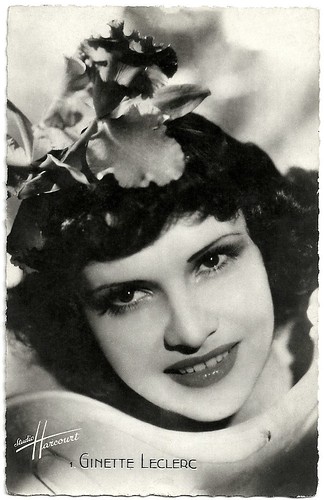
French postcard, no. 1. Photo: Studio Harcourt.
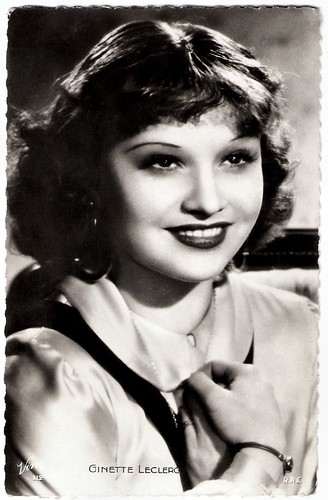
French postcard by Editions Viny, no. 112. Photo: R.A.C.
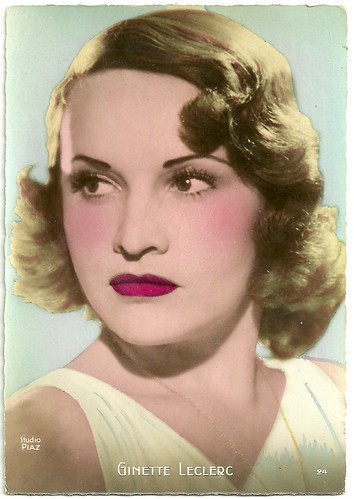
French postcard by Editions O.P., Paris, no. 24. Photo: Studio Piaz.
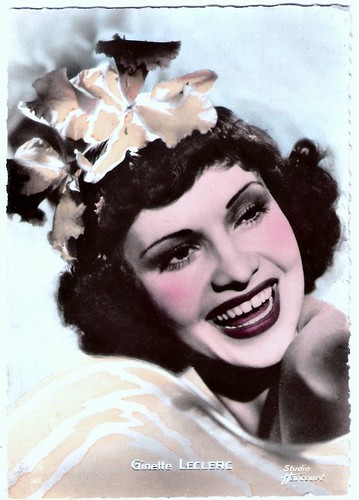
French postcard by Editions et Publication Cinematographiques (EPC), no. 30. Photo: Studio Harcourt.
Ginette Leclerc was born Geneviève Lucie Menut in 1912 in the Paris neighbourhood of Montmartre, where her parents had a jewellery shop. She wanted to fly free and become a dancer, and against her parents’ wishes, she married a dancer, Lucien Leclerc, in 1930. She was only 17, he was 16 years older.
Ginette's marriage didn’t last long, and the two divorced in 1939, but she kept her husband's name. Later, she shared her life for a decade with actor Lucien Gallas. Leclerc had a hard time at the beginning of her career. She posed for daring postcards, and from 1931 on, she played as an extra in films.
In 1933, she was discovered by author Jacques Prévert. He introduced her to director Claude Autant-Lara, who gave her a small role as a coquette in the film operetta Ciboulette (Claude Autant-Lara, 1933), her film debut. This was followed by L’Hôtel du Libre Échange/The Hotel of the Free Exchange (Marc Allégret, 1934), a film adaptation of the Georges Feydeau play in which Leclerc opposed Fernandel.
She was Romilda Pescatore in the adaptation of Luigi Pirandello’s The Late Mathias Pascal: L’homme de nulle part (Pierre Chenal, 1937) starring Pierre Blanchar. And she was an evil, blackmailing girl in a girls' reform school in Prisons sans barreaux/Prisons Without Bars (Léonide Moguy, 1938), starring Annie Ducaux.
In 1938, Ginette Leclerc became a popular star thanks to the comedy La Femme du boulanger/The Baker's Wife (Marcel Pagnol, 1938). Leclerc was Aurélie Castanier, the young, attractive wife of the new, middle-aged baker, played by Raimu. One of their first customers was shepherd Charles Moulin, who was immediately smitten by Leclerc. They ran off together, a turn of events that the stubborn Raimu refuses to acknowledge. As he grows more taciturn, he neglects his work, and soon the whole village anxiously awaits the wife's return, else they'll never see another loaf of bread.
Hal Erickson writes at AllMovie: "The charms of The Baker's Wife are both captivating and fragile; an attempt in 1976 to turn the property into a Broadway musical proved the fragility by ignoring the charm."
In 1938, Leclerc also played in Menaces/Threats (Edmond Gréville, 1939), about a group of hotel guests anguished by the threat of World War II. The film was partly burned a few months after shooting, obliging the crew and cast to retake several scenes. In 1940, the Germans burned the negatives. It was reconstructed in 1944 by Edmond Gréville, adding an optimistic ending instead of the pessimistic ending of 1939.
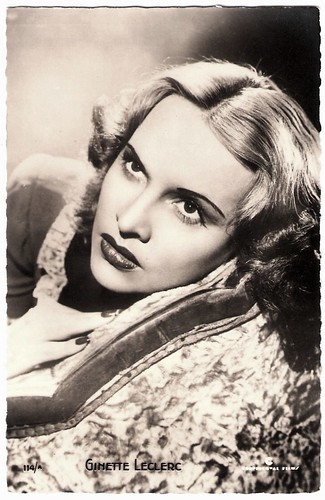
French postcard by Editions Continental, no. 114a. Photo: Continental Films.
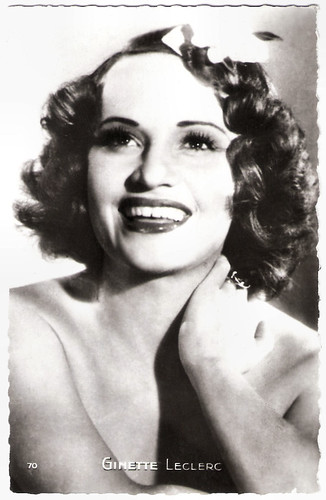
French postcard by Editions P.I., Paris, no. 70.
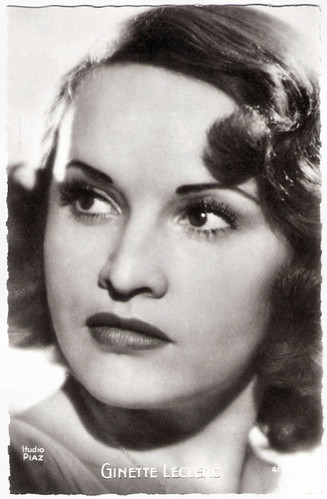
French postcard by Editions O.P., Paris, no. 41. Photo: Studio Piaz.
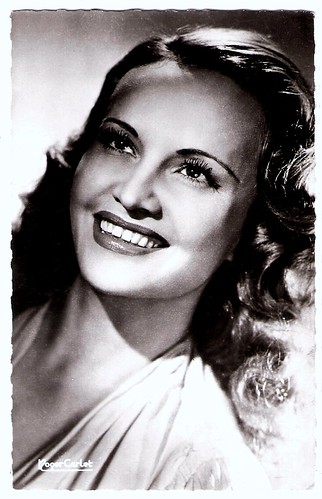
French postcard by Editions O.P, Paris, no. 117. Photo: Roger Carlet.

French postcard in the Raimu series by MPC (Marcel Pagnol Com), no. 36. Photo: Roger Corbeau. Raimu and Ginette Leclerc in La femme du boulanger/The Baker's Wife (Marcel Pagnol, 1938).
Ginette Leclerc’s most famous film is the murder mystery Le Corbeau/The Raven (Henri-Georges Clouzot, 1943), which was successfully reissued in 1947. She played the sensual, alcoholic Denise in love with the country doctor Rémy Germain (Pierre Fresnay), who receives poison pen letters. Hal Erickson at AllMovie reviews: "Though it can now be seen to be a subliminal indictment of the paranoia fomented by the Nazi occupation of France, Le Corbeau (aka The Raven) was condemned as unpatriotic after the liberation, and director Henri-Georges Clouzot was banned from filmmaking until 1947. Based on a story by Clouzot and Louis Chavance, Le Corbeau was remade in Hollywood by Otto Preminger as The 13th Letter (1951)."
Another memorable part was in Le Val d’enfer (Maurice Tourneur, 1943), a film that glorified the Vichy values of work, fatherland and family. Leclerc is a two-faced girl who marries a much older man. During the occupation Ginette Leclerc played with Tino Rossi in Fièvres/Fevers (Jean Delannoy, 1942), with Jean Tissier in Ce n’est pas moi/It's Not Me (Jacques De Baroncelli, 1941), with Georges Marchal in L’homme qui joue avec le feu/The man who plays with fire (Jean de Limur, 1942) and other great actors of that era, but she also ran a notorious cabaret frequented by Germans and pro-Germans.
As she had also worked for the German company Continental, Leclerc was condemned to prison for 9 months and forbidden to work for a year after the Liberation. It took until 1948 before she had substantial film roles again. She was seen in the Franco-Italian production Il fiacre N. 13/Cab Number 13 (Raul André, Mario Mattoli, 1948), the Franco-Belgian production La Maudite (Norbert Benoit, 1948), the neorealist-like film Un homme marche dans la ville/A Man Walks in the City (Marcello Pagliero, 1949), Le Plaisir/Pleasure (Max Ophüls, 1951), and Gas-oil/Hi-Jack Highway (Gilles Grangier, 1955) with Jean Gabin.
In later years, she specialised in portraying faded coquettes and dissipated aristocrats in films like Tropic of Cancer (Joseph Strick, 1970), starring Rip Torn as the author Henry Miller living and loving in 1920s Paris. Leclerc played in almost 100 films. Her long and busy film career didn’t prevent her from also acting in various police TV series, such as Les enquêtes du commissaire Maigret/Maigret (1973-1979) and Les Cinq dernières minutes/The Last Five Minutes (1958-1981), changing over the years from prostitute to madam.
Leclerc also often played on stage in pieces by such authors as Marcel Achard and Jean-Paul Sartre. In 1963, she published her memoirs, simply entitled 'Ma vie privée' (My Private Life). She said of herself: "I am the actress who walked the sidewalk the longest and who has been assassinated most often." Her last film role was in La Barricade du point du jour/The Barricade of the daybreak (René Richon, 1977) with Jean-Luc Bideau when she was 65. Her last TV appearance was in 1981. In 1984, she had two collapses in her Paris apartment, which caused a long revalidation. In 1992, Ginette Leclerc died after a long battle with cancer.
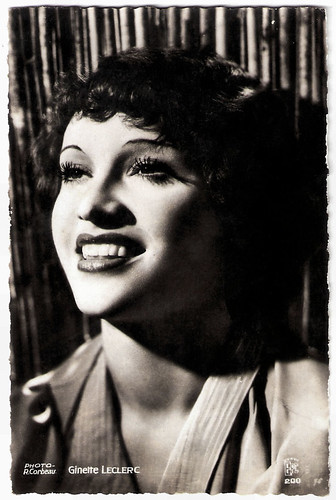
French postcard by Editions et Publication Cinematographiques (EPC), no. 200. Photo: Roger Corbeau.
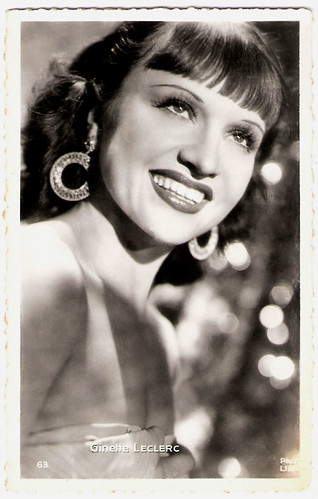
French postcard by Edit. Chantal, Rueil, no. 63. Photo: Limo.
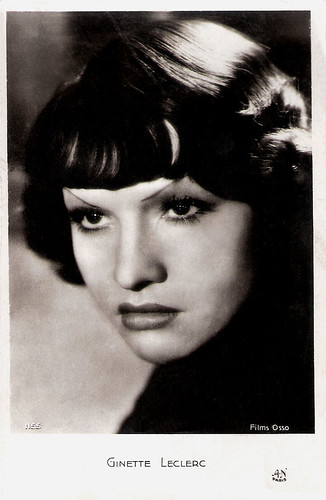
French postcard by A.N., Paris, no. 1155. Photo: Films Osso.
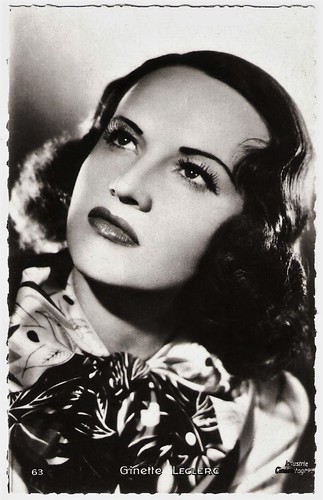
French postcard, no. 63. Photo: Industrie Cinématographiques.
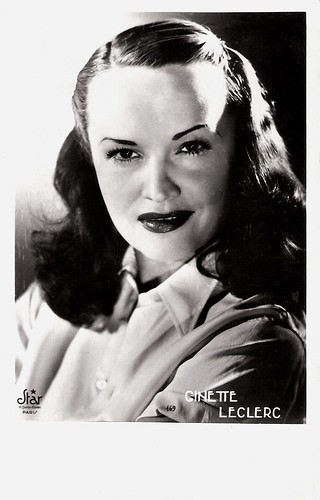
French postcard by Edit. P.I., Paris, offered by Korès, no. 169. Photo: Star, Paris.
Sources: Hal Erickson (AllMovie - Page now defunct), Caroline Hanotte (CinéArtistes - French), CinéMémorial (Now defunct), Wikipedia (French and English) and IMDb.
This post was last updated on 9 March 2025.

French postcard in the Raimu series by MPC (Marcel Pagnol Com), no. 12. Photo: Roger Corbeau. Raimu and Ginette Leclerc in La femme du boulanger/The Baker's Wife (Marcel Pagnol, 1938).

French postcard, no. 1. Photo: Studio Harcourt.

French postcard by Editions Viny, no. 112. Photo: R.A.C.

French postcard by Editions O.P., Paris, no. 24. Photo: Studio Piaz.

French postcard by Editions et Publication Cinematographiques (EPC), no. 30. Photo: Studio Harcourt.
Daring postcards
Ginette Leclerc was born Geneviève Lucie Menut in 1912 in the Paris neighbourhood of Montmartre, where her parents had a jewellery shop. She wanted to fly free and become a dancer, and against her parents’ wishes, she married a dancer, Lucien Leclerc, in 1930. She was only 17, he was 16 years older.
Ginette's marriage didn’t last long, and the two divorced in 1939, but she kept her husband's name. Later, she shared her life for a decade with actor Lucien Gallas. Leclerc had a hard time at the beginning of her career. She posed for daring postcards, and from 1931 on, she played as an extra in films.
In 1933, she was discovered by author Jacques Prévert. He introduced her to director Claude Autant-Lara, who gave her a small role as a coquette in the film operetta Ciboulette (Claude Autant-Lara, 1933), her film debut. This was followed by L’Hôtel du Libre Échange/The Hotel of the Free Exchange (Marc Allégret, 1934), a film adaptation of the Georges Feydeau play in which Leclerc opposed Fernandel.
She was Romilda Pescatore in the adaptation of Luigi Pirandello’s The Late Mathias Pascal: L’homme de nulle part (Pierre Chenal, 1937) starring Pierre Blanchar. And she was an evil, blackmailing girl in a girls' reform school in Prisons sans barreaux/Prisons Without Bars (Léonide Moguy, 1938), starring Annie Ducaux.
In 1938, Ginette Leclerc became a popular star thanks to the comedy La Femme du boulanger/The Baker's Wife (Marcel Pagnol, 1938). Leclerc was Aurélie Castanier, the young, attractive wife of the new, middle-aged baker, played by Raimu. One of their first customers was shepherd Charles Moulin, who was immediately smitten by Leclerc. They ran off together, a turn of events that the stubborn Raimu refuses to acknowledge. As he grows more taciturn, he neglects his work, and soon the whole village anxiously awaits the wife's return, else they'll never see another loaf of bread.
Hal Erickson writes at AllMovie: "The charms of The Baker's Wife are both captivating and fragile; an attempt in 1976 to turn the property into a Broadway musical proved the fragility by ignoring the charm."
In 1938, Leclerc also played in Menaces/Threats (Edmond Gréville, 1939), about a group of hotel guests anguished by the threat of World War II. The film was partly burned a few months after shooting, obliging the crew and cast to retake several scenes. In 1940, the Germans burned the negatives. It was reconstructed in 1944 by Edmond Gréville, adding an optimistic ending instead of the pessimistic ending of 1939.

French postcard by Editions Continental, no. 114a. Photo: Continental Films.

French postcard by Editions P.I., Paris, no. 70.

French postcard by Editions O.P., Paris, no. 41. Photo: Studio Piaz.

French postcard by Editions O.P, Paris, no. 117. Photo: Roger Carlet.

French postcard in the Raimu series by MPC (Marcel Pagnol Com), no. 36. Photo: Roger Corbeau. Raimu and Ginette Leclerc in La femme du boulanger/The Baker's Wife (Marcel Pagnol, 1938).
Faded coquettes and dissipated aristocrats
Ginette Leclerc’s most famous film is the murder mystery Le Corbeau/The Raven (Henri-Georges Clouzot, 1943), which was successfully reissued in 1947. She played the sensual, alcoholic Denise in love with the country doctor Rémy Germain (Pierre Fresnay), who receives poison pen letters. Hal Erickson at AllMovie reviews: "Though it can now be seen to be a subliminal indictment of the paranoia fomented by the Nazi occupation of France, Le Corbeau (aka The Raven) was condemned as unpatriotic after the liberation, and director Henri-Georges Clouzot was banned from filmmaking until 1947. Based on a story by Clouzot and Louis Chavance, Le Corbeau was remade in Hollywood by Otto Preminger as The 13th Letter (1951)."
Another memorable part was in Le Val d’enfer (Maurice Tourneur, 1943), a film that glorified the Vichy values of work, fatherland and family. Leclerc is a two-faced girl who marries a much older man. During the occupation Ginette Leclerc played with Tino Rossi in Fièvres/Fevers (Jean Delannoy, 1942), with Jean Tissier in Ce n’est pas moi/It's Not Me (Jacques De Baroncelli, 1941), with Georges Marchal in L’homme qui joue avec le feu/The man who plays with fire (Jean de Limur, 1942) and other great actors of that era, but she also ran a notorious cabaret frequented by Germans and pro-Germans.
As she had also worked for the German company Continental, Leclerc was condemned to prison for 9 months and forbidden to work for a year after the Liberation. It took until 1948 before she had substantial film roles again. She was seen in the Franco-Italian production Il fiacre N. 13/Cab Number 13 (Raul André, Mario Mattoli, 1948), the Franco-Belgian production La Maudite (Norbert Benoit, 1948), the neorealist-like film Un homme marche dans la ville/A Man Walks in the City (Marcello Pagliero, 1949), Le Plaisir/Pleasure (Max Ophüls, 1951), and Gas-oil/Hi-Jack Highway (Gilles Grangier, 1955) with Jean Gabin.
In later years, she specialised in portraying faded coquettes and dissipated aristocrats in films like Tropic of Cancer (Joseph Strick, 1970), starring Rip Torn as the author Henry Miller living and loving in 1920s Paris. Leclerc played in almost 100 films. Her long and busy film career didn’t prevent her from also acting in various police TV series, such as Les enquêtes du commissaire Maigret/Maigret (1973-1979) and Les Cinq dernières minutes/The Last Five Minutes (1958-1981), changing over the years from prostitute to madam.
Leclerc also often played on stage in pieces by such authors as Marcel Achard and Jean-Paul Sartre. In 1963, she published her memoirs, simply entitled 'Ma vie privée' (My Private Life). She said of herself: "I am the actress who walked the sidewalk the longest and who has been assassinated most often." Her last film role was in La Barricade du point du jour/The Barricade of the daybreak (René Richon, 1977) with Jean-Luc Bideau when she was 65. Her last TV appearance was in 1981. In 1984, she had two collapses in her Paris apartment, which caused a long revalidation. In 1992, Ginette Leclerc died after a long battle with cancer.

French postcard by Editions et Publication Cinematographiques (EPC), no. 200. Photo: Roger Corbeau.

French postcard by Edit. Chantal, Rueil, no. 63. Photo: Limo.

French postcard by A.N., Paris, no. 1155. Photo: Films Osso.

French postcard, no. 63. Photo: Industrie Cinématographiques.

French postcard by Edit. P.I., Paris, offered by Korès, no. 169. Photo: Star, Paris.
Sources: Hal Erickson (AllMovie - Page now defunct), Caroline Hanotte (CinéArtistes - French), CinéMémorial (Now defunct), Wikipedia (French and English) and IMDb.
This post was last updated on 9 March 2025.
No comments:
Post a Comment